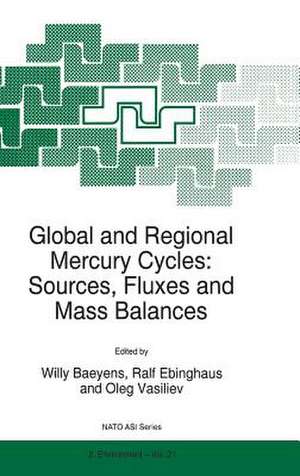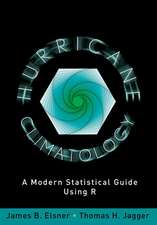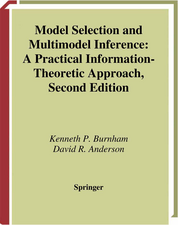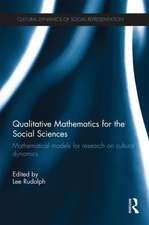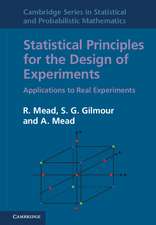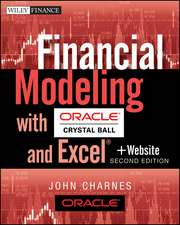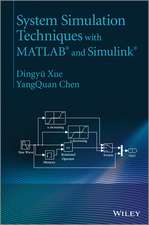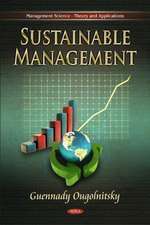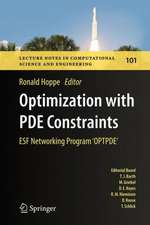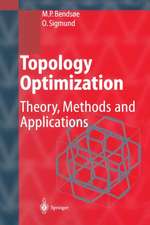Global and Regional Mercury Cycles: Sources, Fluxes and Mass Balances: NATO Science Partnership Subseries: 2, cartea 21
Editat de W. Baeyens, Ralf Ebinghaus, Oleg Vasilieven Limba Engleză Hardback – 31 oct 1996
Audience: Environmental scientists, legislators, politicians and the interested citizen wishing to gain a clear picture of the biogeochemical cycling of mercury.
| Toate formatele și edițiile | Preț | Express |
|---|---|---|
| Paperback (1) | 1829.86 lei 6-8 săpt. | |
| SPRINGER NETHERLANDS – 28 sep 2011 | 1829.86 lei 6-8 săpt. | |
| Hardback (1) | 1846.40 lei 6-8 săpt. | |
| SPRINGER NETHERLANDS – 31 oct 1996 | 1846.40 lei 6-8 săpt. |
Din seria NATO Science Partnership Subseries: 2
- 15%
 Preț: 638.43 lei
Preț: 638.43 lei - 5%
 Preț: 1420.29 lei
Preț: 1420.29 lei -
 Preț: 390.84 lei
Preț: 390.84 lei - 18%
 Preț: 949.90 lei
Preț: 949.90 lei -
 Preț: 401.24 lei
Preț: 401.24 lei - 15%
 Preț: 653.14 lei
Preț: 653.14 lei - 5%
 Preț: 1414.64 lei
Preț: 1414.64 lei - 15%
 Preț: 642.18 lei
Preț: 642.18 lei - 18%
 Preț: 949.90 lei
Preț: 949.90 lei -
 Preț: 380.07 lei
Preț: 380.07 lei - 15%
 Preț: 643.84 lei
Preț: 643.84 lei - 18%
 Preț: 1839.63 lei
Preț: 1839.63 lei -
 Preț: 416.64 lei
Preț: 416.64 lei - 18%
 Preț: 1234.77 lei
Preț: 1234.77 lei - 18%
 Preț: 1834.90 lei
Preț: 1834.90 lei - 18%
 Preț: 950.96 lei
Preț: 950.96 lei - 15%
 Preț: 655.78 lei
Preț: 655.78 lei -
 Preț: 403.53 lei
Preț: 403.53 lei -
 Preț: 381.98 lei
Preț: 381.98 lei - 18%
 Preț: 1836.94 lei
Preț: 1836.94 lei - 15%
 Preț: 645.47 lei
Preț: 645.47 lei - 18%
 Preț: 946.87 lei
Preț: 946.87 lei - 18%
 Preț: 1227.99 lei
Preț: 1227.99 lei - 18%
 Preț: 1232.57 lei
Preț: 1232.57 lei -
 Preț: 398.15 lei
Preț: 398.15 lei - 18%
 Preț: 1232.71 lei
Preț: 1232.71 lei - 18%
 Preț: 1223.88 lei
Preț: 1223.88 lei - 18%
 Preț: 1228.77 lei
Preț: 1228.77 lei
Preț: 1846.40 lei
Preț vechi: 2251.71 lei
-18% Nou
Puncte Express: 2770
Preț estimativ în valută:
353.32€ • 377.81$ • 294.58£
353.32€ • 377.81$ • 294.58£
Carte tipărită la comandă
Livrare economică 18 aprilie-02 mai
Preluare comenzi: 021 569.72.76
Specificații
ISBN-13: 9780792343141
ISBN-10: 079234314X
Pagini: 563
Ilustrații: XXVIII, 563 p.
Dimensiuni: 160 x 240 x 44 mm
Greutate: 1.3 kg
Ediția:1996
Editura: SPRINGER NETHERLANDS
Colecția Springer
Seria NATO Science Partnership Subseries: 2
Locul publicării:Dordrecht, Netherlands
ISBN-10: 079234314X
Pagini: 563
Ilustrații: XXVIII, 563 p.
Dimensiuni: 160 x 240 x 44 mm
Greutate: 1.3 kg
Ediția:1996
Editura: SPRINGER NETHERLANDS
Colecția Springer
Seria NATO Science Partnership Subseries: 2
Locul publicării:Dordrecht, Netherlands
Public țintă
ResearchCuprins
1. Analytical Aspects on the Determination of Mercury.- 1.1. Mercury Analysis and Speciation in Environmental Samples.- 2. Mercury Fluxes and Budgets.- 2.1. Global Regional and Local Mercury Budgets.- 2.1.1. Trends in Atmospheric Mercury Concentrations over the Atlantic Ocean and at the Wank Summit, and the Resulting Constraints on the Budget of Atmospheric Mercury.- 2.1.2. The Global Mercury Cycle: Oceanic and Anthropogenic Aspects.- 2.1.3. Estimation of Atmospheric Input and Evasion Fluxes of Mercury to and from the Great Lakes.- 2.1.4. A Regional Mercury Budget for Siberia and the Role of the Region in Global Cycling of the Metal.- 2.1.5. Emission and Local Deposition Estimates of Atmospheric Mercury in North-Western and Central Europe.- 2.2. Emission Inventories and Regional Transport Models for Mercury.- 2.2.1. Emission Inventories of Atmospheric Mercury from Anthropogenic Sources.- 2.2.2. Inventory of North American Hg Emissions to the Atmosphere.- 2.2.3. Numerical Modeling of Regional Transport, Chemical Transformations and Deposition Fluxes of Airborne Mercury Species.- 2.2.4. A Model of the Chemical Transformation of Mercury and its Long-Range Atmospheric Transport.- 2.3. Mercury Cycling in the Oceans.- 2.3.1. Mercury Fluxes at the Ocean Margins.- 2.3.2. Sources, Sinks and Biogeochemical Cycling of Mercury in the Ocean.- 2.4. Mercury in Lakes, Rivers and Estuaries.- 2.4.1. Mercury in the Katun River Basin: A Case Study of a Naturally Polluted System.- 2.4.2. Particulate, Dissolved and Methylmercury Budgets for the Scheldt Estuary (Belgium and the Netherlands).- 2.4.3. Mercury Distribution and Fluxes in Lake Baikal.- 2.4.4. The Elbe River: A Special Example for a European River Contaminated Heavily with Mercury.- 2.4.5. Mass Balance Studies of Mercury and MethylMercury in Small Temperate/Boreal Lakes of the Northern Hemisphere.- 2.5. Hg in Terrestrial Systems.- 2.5.1. Forests and the Global Biogeochemical Cycle of Mercury.- 2.5.2. Terrestrial Mercury and Methylmercury Budgets for Scandinavia.- 2.5.3. The Role of Organic Matter in Mercury Cycle.- 3. Natural and Industrial Sources of Mercury.- 3.1. Eastern Europe and Siberia.- 3.1.1. Mercury Contamination of the Environment due to Gold Mining in Zabaikalye.- 3.1.2. Industrial Mercury Sources in Siberia.- 3.1.3. Mercury Speciation in Mineral Matter as an Indicator of Sources of Contamination.- 3.1.4. Natural Mercury Sources in the Environment: Contribution of Siberia.- 3.1.5. Mercury in Geological Systems.- 3.1.6. Mercury in Soils of the Southern West Siberia.- 3.1.7. Case Studies on Mercury Related Environmental Problems in Hungary.- 3.1.8. Mercury in the Environment of the Central Part of the Balkan Peninsula.- 3.2. Tropical Regions.- 3.2.1. Scope Project: Evaluation of the Role and Distribution of Mercury on Ecosystems with Special Emphasis on Tropical Regions.- 3.2.2. Lessons and Questions from Studies on Mercury in the Amazon Region.- 4. Conclusions of the Working Group Discussions.- 4.1. Working Group Report on Atmospheric Mercury.- 4.2. Working Group Report on Oceanic Mercury Cycling.- 4.3. Working Group Report on Terrestrial Mercury Cycling.- 4.4. Working Group Report on Inland Waters.
Recenzii
`I recommend this book to any ecotoxicologist who will sooner or later have to deal with the problems of mercury contamination.'
International Journal of Environment and Pollution, 10:1 (1998)
International Journal of Environment and Pollution, 10:1 (1998)
